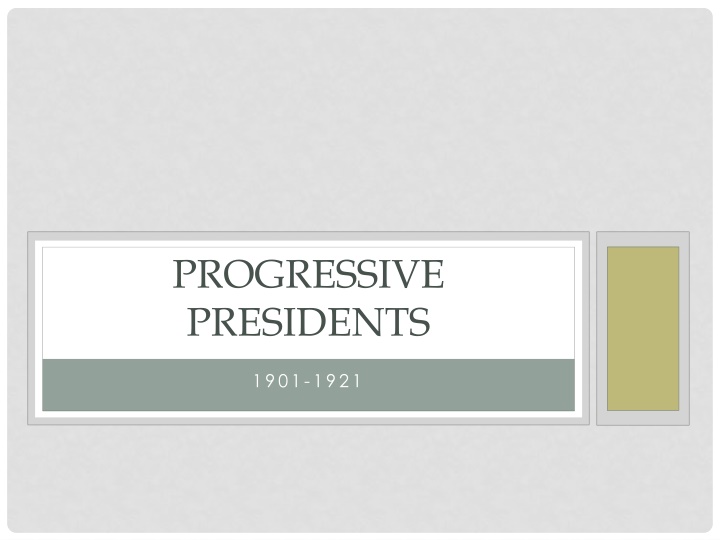
Progressive Presidents 1901-1921 and the Evolution of US Politics
Explore the dynamic era of Progressive Presidents from 1901 to 1921, including the impactful leadership of Teddy Roosevelt and William Howard Taft. Witness the ideological shifts, policy implementations, conflicts, and the historic Election of 1912 leading to Woodrow Wilson's presidency. Discover how these leaders shaped US politics, initiated reforms, and navigated significant challenges during this transformative period.
Download Presentation

Please find below an Image/Link to download the presentation.
The content on the website is provided AS IS for your information and personal use only. It may not be sold, licensed, or shared on other websites without obtaining consent from the author. If you encounter any issues during the download, it is possible that the publisher has removed the file from their server.
You are allowed to download the files provided on this website for personal or commercial use, subject to the condition that they are used lawfully. All files are the property of their respective owners.
The content on the website is provided AS IS for your information and personal use only. It may not be sold, licensed, or shared on other websites without obtaining consent from the author.
E N D
Presentation Transcript
PROGRESSIVE PRESIDENTS 1901-1921
TEDDY ROOSEVELT 1901-1909 Square Deal to determine bad from good corporations and regulate as needed under the Sherman Antitrust Act Helped protect nature through the conservation movement
WILLIAM HOWARD TAFT 1909-1913 Chosen by Roosevelt as his successor he won the presidency Was even more of a trust-buster than Roosevelt had been Supported the 16th amendment that which enacted a graduated income tax
FALL OUT WITH PROGRESSIVES Taft didn t appoint any progressives to his cabinet Taft signed the Payne-Aldrich Tariff which lowered tariffs but not as much as the progressives wanted
FALL OUT WITH ROOSEVELT Finally, the new secretary of the interior, Richard Ballinger returned some of the forest reserves to public domain allowing mining and lumber companies to use it Pinchot accused Ballinger of making deals with businesses and undoing the goals of Roosevelt Taft fired Pinchot as head of Bureau of Forestry
ELECTION OF 1912 Roosevelt, furious with Taft, returned from his African Safari to run against Taft in the election of 1912 Roosevelt split the Republican party when he created his Bull Moose Party Taft and Roosevelt ran against each other as well as Democrat Woodrow Wilson, and Socialist Eugene V. Debs
WOODROW WILSON Wilson was able to very easily win the election Wilson s program, The New Freedom, tried to both limit the power of the federal government while also limiting the power of big businesses
WILSON AS A PROGRESSIVE Wilson implemented the Underwood Tariff which lowered taxes on imported goods and also imposed a graduated income tax on the wealthiest 5% of the population Wilson also strengthened the Unions through the Clayton Act and outlawed child labor and established an 8 hours work day through the Keating-Owen Act and the Adamson Act
ROLE OF GOVERNMENT Under Wilson the Federal Reserve System was created. It was overseen by a board appointed by the president and controlled interest rates, issued currency, and helped prevent them from failing The Federal Trade Commission was also created during this time intended to investigate and prevent monopolies and unfair business practices
